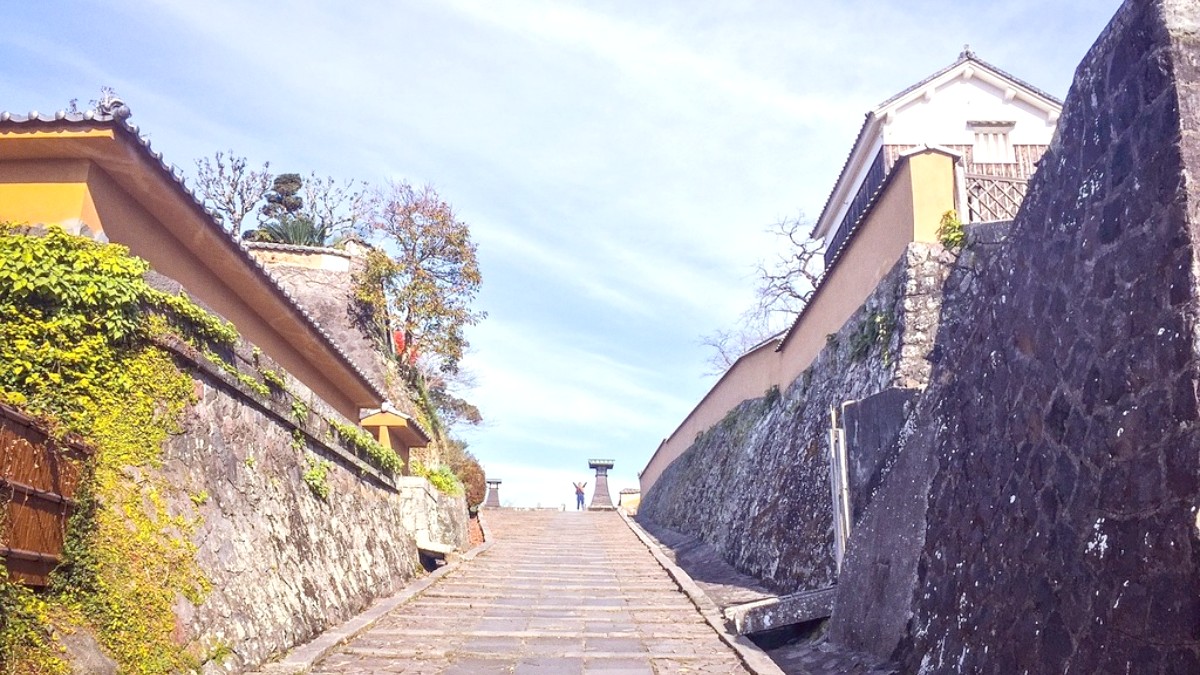
Kyushu, Japan
Kumamoto Castle ranks among Japan's most impressive and historically significant castles, built by Kato Kiyomasa in the early 17th century. It is famous for its unique curving stone walls, known as musha-gaeshi.
The castle sustained heavy damage during the 2016 Kumamoto earthquakes, but extensive restoration efforts are ongoing. Visitors access the grounds, explore restored sections, and ascend the main keep for panoramic city views.
Sakura-no-kōji: 9:00 AM - 7:00 PM. Wakuwaku-za: 9:00 AM - 5:30 PM (last entry 5:00 PM). Free entry to Sakura-no-kōji; Wakuwaku-za ¥300 fee or combined ticket.
Sprawling Nichiren Buddhist temple, burial site for Kato Kiyomasa. Features an impressive stone staircase and pagoda. Grounds are always open.
Well-preserved samurai house with traditional Japanese architecture and a serene garden. Insights into samurai daily life during the Edo period. Located within Kumamoto Castle outer grounds.
Typically 9:00 AM - 5:00 PM for the residence. Check for seasonal variations. Entry may be included with castle ticket or a separate small fee.
These sites offer deep understanding of Kumamoto's past, from religious practices to feudal samurai life.
Accessible from Kumamoto city center, often a short tram or bus ride away.
Kumamoto Prefecture presents dramatic natural beauty, characterized by volcanic landscapes, lush gorges, and scenic viewpoints, for a refreshing escape into nature.
One of the world's largest active calderas, located 1.5-2 hours from Kumamoto city. Central cones (Aso Gogaku) include the active Nakadake crater.
Daikanbo offers panoramic caldera views ("sleeping Buddha"). Kusa-Senri is a vast grassland for walks and horseback riding with foreground views of Nakadake.
Access to Nakadake crater depends on volcanic activity. Check the official Aso Volcano Disaster Prevention Council website for alerts before visiting.
Beautiful, tranquil gorge northeast of Kumamoto city (about an hour's drive). Known for clear, cool waters, numerous small waterfalls, and lush forest. A refreshing escape.
Series of scenic waterfalls near Yatsushiro, south of Kumamoto. Accessible from Kumamoto, offering a pleasant natural attraction away from larger crowds. Multi-tiered cascades.
These natural sites highlight Kumamoto Prefecture's diverse geography and offer opportunities for hiking, photography, and peaceful outdoor moments.
Kumamoto Prefectural Office Ginkgo Avenue transforms into a spectacular golden tunnel in autumn when its numerous ginkgo trees change color. A stunning, free photo opportunity, less frequented by international tourists.
Kamitori and Shimotori Shopping Arcades, though central, are often overlooked. Explore diverse shops, sample local eateries, and observe daily city rhythm. Offers shelter from weather.
Kumamoto Zoological and Botanical Garden is a large zoo and botanical garden, popular for local families. A full day of entertainment observing animal species and plant collections.
Beyond the main attractions, Kumamoto holds several lesser-known spots that present distinct local experiences and quieter moments.
A well-planned itinerary allows you to make the most of your visit to Kumamoto's diverse attractions.
Consider grouping nearby sites to optimize travel time and experience a blend of historical, cultural, and natural wonders.
Start your day early to enjoy the tranquility of popular sites before larger crowds arrive.
Transition to gardens, museums, or shopping areas for varied experiences.
Kumamoto acts as an excellent base for exploring the wider prefecture's natural wonders.
Kumamoto's city center is walkable, and its public transport network is efficient.
Kumamoto is a generally safe destination.
Kumamoto presents a very safe environment. Apply standard city precautions in crowded areas, especially during peak hours or late at night. Public spaces are well-lit and active.
Many public facilities and newer attractions in Kumamoto offer accessibility features. Older sites, like portions of Kumamoto Castle, may have limited accessibility due to historical architecture or ongoing restoration.
For Mount Aso, always check the Aso Volcano Disaster Prevention Council website for the latest alerts and access restrictions before planning your visit. Conditions change rapidly.
Familiarize yourself with emergency numbers: Police 110, Ambulance/Fire 119. Local police boxes (Koban) are throughout the city.
Hospitals and clinics are available. Carry travel insurance. English-speaking medical staff may be limited outside major facilities.
Summer is hot and humid; winter is cold. Be ready for seasonal weather changes. Typhoon season is from late summer to early autumn.
Japan is earthquake-prone. Familiarize yourself with basic earthquake safety procedures in your accommodation.
Traffic drives on the left. Pedestrians should use designated crossings. Be aware of cyclists on sidewalks.
Kumamoto's trams and buses are generally accessible, with features for various needs.
Accessibility at cultural and historical sites varies, with ongoing efforts for improvement.
It is highly advisable to acquire comprehensive travel insurance before your trip.
This coverage will shield you from unforeseen circumstances like medical emergencies, trip cancellations, or lost luggage.
Observing local customs makes for a more respectful and enjoyable experience in Kumamoto.
Japanese society values politeness, respect, and harmony. A polite demeanor will be appreciated.
Meal times in Japan have specific customs that enhance the dining experience.
Public bathhouses and onsen have strict hygiene rules for a comfortable experience for all.
Some onsen may have restrictions on tattoos, or require covering them. Inquire beforehand.
Be mindful and respectful when taking photos, especially in sacred or private spaces.
Be aware of your surroundings and avoid blocking pathways or views for others.
Japan maintains high cleanliness standards. Proper waste separation is important.
Line up orderly for trains, buses, and elevators. Wait for passengers to exit before boarding.
Set phones to silent mode on public transport. Avoid talking on the phone; keep conversations quiet.
Offer priority seats to the elderly, pregnant women, or those with disabilities.